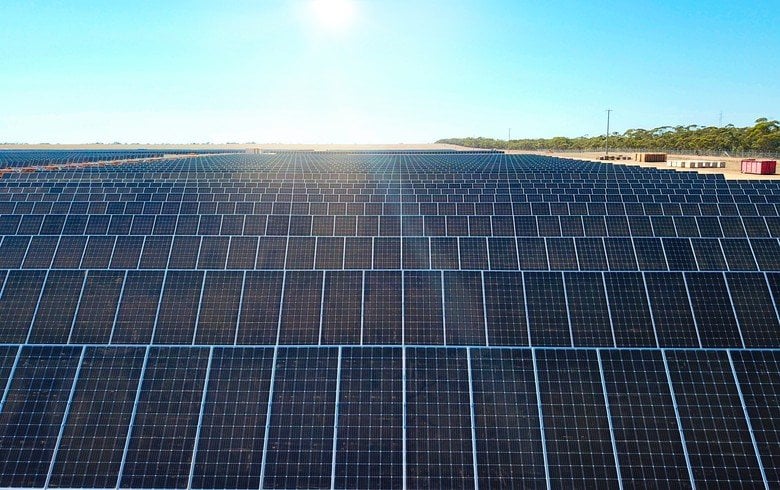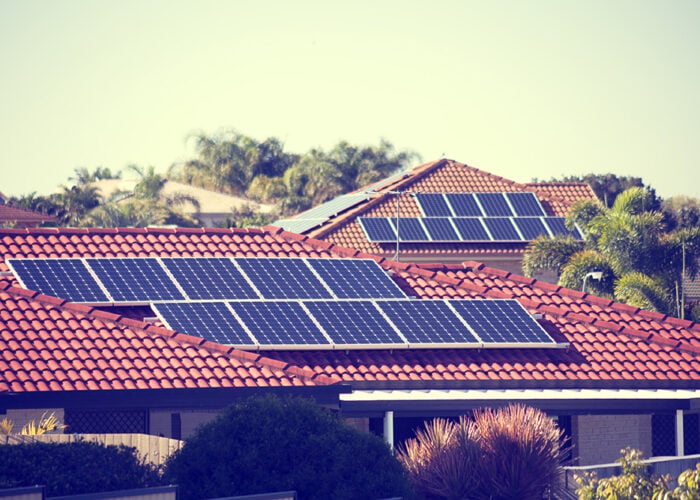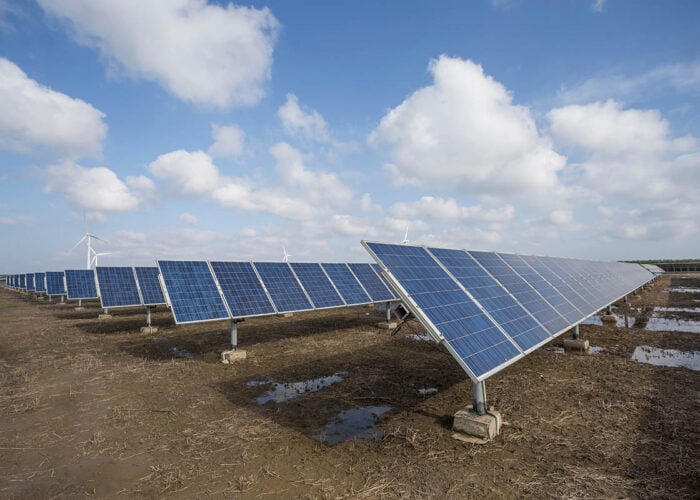
Earlier this year, Recurrent Energy sold the storage component of its Mannum solar-plus-storage project in South Australia to Epic Energy. The latter firm is an Australian power company that is predominantly active in the gas sector, owning the Moomba to Adelaide Pipeline System and South East Pipeline System in the Australian state, and acquired the solar power generation components of the facility in 2020.
While the scale of the project is not notable – in total the facility will have a power generation capacity of 46MW and its storage component will have a capacity of 100MW/200MWh – the project will be the first to deploy Trina Solar’s 210 p-type 650W modules, the latest to be developed by the Chinese manufacturing giant.
Unlock unlimited access for 12 whole months of distinctive global analysis
Photovoltaics International is now included.
- Regular insight and analysis of the industry’s biggest developments
- In-depth interviews with the industry’s leading figures
- Unlimited digital access to the PV Tech Power journal catalogue
- Unlimited digital access to the Photovoltaics International journal catalogue
- Access to more than 1,000 technical papers
- Discounts on Solar Media’s portfolio of events, in-person and virtual
The growing influence of an industry heavyweight in Australia could be of benefit to the country, and achieving its significant decarbonisation targets, as Australia aims to meet 82% of its energy demand with renewables by 2030, up from just over 30% as of the end of 2022. The country has already seen a flurry of deals for solar power projects – from clean power developer EDP Renewables to mining giant Rio Tinto – and there is growing interest in developing a more robust solar supply chain for Australia more broadly.
Just this week, the Australian Renewable Energy Agency published a report arguing that Australia could develop a 10GW polysilicon manufacturing industry, alongside a further 5GW of capacity of ingot, wafer, cell and module production capacity by the end of the decade. As a result, the Mannum project sits at the confluence of a fossil fuel major keen to decarbonise its operations, a solar industry heavyweight looking to implement its latest innovation, and a national government keen to expand all aspects of its domestic solar industry.
Expanding capacity and expanding influence
“Introducing the first cutting-edge 210 p-type 650W modules and Agile 1P tracker technology in Australia positions the project as a trailblazer,” begins Edison Zhou, head of Australia, New Zealand and the Pacific Islands at Trina Solar, commenting on the company’s latest module and tracker deployment.
The panels are part of the company’s Vertex series of modules, and have a power conversion efficiency of 21.7%. While rival manufacturer LONGi has developed a tandem solar cell with a much higher conversion efficiency of 33.9%, such cells are not yet in commercial production, and Zhou is proud of the company’s work at the Mannum project thus far.
“Looking ahead, we are excited about the prospect of offering more solution-based projects, contributing to the advancement of sustainable energy solutions,” adds Zhou. While the Mannum project is relatively small, in terms of total solar capacity, there is the potential for expansion in the future, which Zhou was keen to stress.
“Mannum Solar Farm is currently achieving a 5MW output, and we are excited to share that within the next two to four weeks, we anticipate reaching its full potential with an impressive 30MWac output,” says Zhou. “We’re proud of the progress and look forward to maximising the farm’s capacity to contribute sustainable energy to our community.”
Such projects are nothing new for the company – its subsidiary, TrinaTracker, deployed trackers at a Colombian project as recently as September 2023 – but could be notable as the investment in p-type modules runs counter to the company’s own stated ambition to shift its focus to n-type panels over the course of the decade.
Perhaps the relatively low cost of p-type panels has encouraged Trina Solar to continue to invest in the technology, or its technological expertise is of benefit as it looks to expand its footprint in Australia and the Pacific Islands, a region where it has not historically enjoyed significant influence.
Late last year, Trina Solar signed a deal to supply 1.5GW of modules to solar projects in the area, and as interest in Chinese-made solar products in Europe and the US cools, markets such as this could be of increasing importance to companies such as Trina Solar.
Access to the Australian energy transition
Perhaps unsurprisingly, Zhou is keen to stress the importance of the solar sector in meeting Australia’s decarbonisation goals. However, there are questions as to how Australia will integrate solar power into its energy mix, with interest apparently waning in utility-scale deployments; in 2022, Australia’s large-scale solar deployments fell by 50% compared to the previous year.
“Utility-scale projects are definitely essential for meeting broader energy demands and achieving economies of scale,” says Zhou, stressing that utility-scale will continue to play a role in Australian solar. “Australia, with its vast land availability and abundant sunlight, has seen significant investments in utility-scale solar farms.”
However, the cooling of interest in utility-scale solar has occurred just as interest in residential solar, and rooftop projects in particular, is growing considerably. Distributed rooftop solar met 14% of Australia’s energy needs during the summer months at the start of 2023, and Australia has become something of a poster child for large-scale rooftop deployment.
“The idea of transforming idle rooftops into powerhouses to reduce one’s electricity bill and carbon footprint is very appealing,” adds Zhou, suggesting that this sector could be of interest to Trina Solar. The company launched a new module, designed for use in the rooftop sector in particular, earlier this year, and there is a strong business case for greater rooftop deployments in Australia in particular.
“Most businesses also have a closing deadline on achieving their net zero targets in 2030-2050. Rooftop-scale solar becomes the top choice as it is easy and quick to install and cost effective,” says Zhou. “In the residential segment, one in every three Australian households, more than 3.6 million homes, now generates electricity from solar.”
However, some are being left behind by this wave of interest in residential solar notably renters, and those who do not own their own homes. A report from Macquaria University found that more than 90% of tenants in Australia lacked access to the energy generated, and savings produced, by rooftop solar installations, and ensuring the benefits of such projects are accessible will be a challenge for both local and the national government.
While such structural reforms are perhaps beyond the remit of a company such as Trina Solar, Zhou notes that storage, in particular, “can provide a reliable and efficient operation of the electricity system.”
Indeed, the Australian Renewable Energy Agency received applications to fund A$1.3 billion (US$840 million) of new storage projects last year, suggesting there is considerable interest in the storage sector in Australia, and that there is, at least, a perception that such investment could help bridge this gap between those who have access to solar projects, and those who do not.
A mature market and a mature company
This combination of interest in solar projects and infrastructure, and Trina Solar’s own expertise in the sector, means that the company may continue to invest in the region. Zhou notes that the regulatory environment is also favourable, a not insignificant consideration for solar companies.
“Australia is a great country to work in and a dynamic environment for solar projects,” says Zhou. “The country has abundant sunlight and is a mature market compared to many others. Trina Solar is ready to support the government’s efforts and businesses on the green energy transition journey.”
The development of the Australian solar sector could also set a blueprint for Trina Solar in the region, where an initial flurry of capacity additions is followed by interest and investment in supporting infrastructure, such as storage. Between December 2013 and December 2023, the total capacity of Australian solar projects jumped from 3.2GW to 34.2GW, and with a strong solar sector in place, attention is now shifting towards supporting infrastructure.
Similarly, Trina Solar’s business is based on solar module production, but as it invests in mature markets, and its own expertise grows, it has started to commit more resources to other forms of solar technology, namely trackers.
“Solar modules will continue to be our core business, but it is true that trackers are growing part of our business,” says Zhou, drawing attention to the growing role of trackers in the company’s business. “Because we are the only solar module manufacturer that makes trackers and energy storage systems, a key focus for Trina Solar is our new market positioning as a total solutions provider.”
Ultimately, as both this mature market and this industry veteran continue to grow their operations, there will be ample opportunities for both to expand their current operations, and invest in new components of and processes in the solar sector.
As Zhou concludes: “The rapid growth of solar in Australia means industry players are thinking of new ways to meet the growing need for flexibility.”







